![]()
![]()
![]()
Use LEFT and RIGHT arrow keys to navigate between flashcards;
Use UP and DOWN arrow keys to flip the card;
H to show hint;
A reads text to speech;
16 Cards in this Set
- Front
- Back
|
Shaefer Model
|
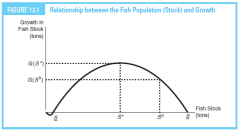
Posits relationship between growth of fish population and size of fish population
|
|
|
Static Efficient Sustainable Yield for a Fishery
|
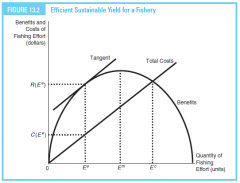
Inclusion of costs to the Shaefer model to determine maximum net benefits; different from dynamic efficient sustainable yield which incorporates discounting
Three assumptions: 1. price of fish is constant and does not vary with amount sold 2. MC per unit of fishing effort is constant 3. amount of fish caught per unit of effort expended is proportional to the size of fish population (or, the smaller the population, the fewer fish caught per unit of effort) Efficient yield at Ee |
|
|
Dynamic Efficient Sustainable Yield for a Fishery
|
Effect of a positive discount rate for the management of a fishery: the higher the discount rate, the higher the cost to the resource owner of maintaining any given resource stock.
When introduced, efficient level of effort is increased from static efficient sustained yield with a corresponding decrease in equilibrium population level. Efficient yield at Ec |
|
|
External costs created by unrestricted open-access resources
|
1. Contemporaneous: external costs borne by current generation from overcommitment of resources, leading to lower current rates of return
2. Intergenerational: external costs borne by future generations from reduction of stock, leading to lower future profits |
|
|
Market Allocation in a Fishery (graph)
|
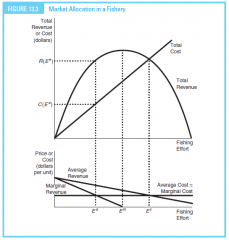
|
|
|
Characteristics of an efficient quota system (for fisheries; ITQs)
|
1. Entitles the holder to catch a specified share of the total authorized catch of a specific type of fish
2. Catch authorized by quotas held by all fisherman should be equal to the efficient catch for the fishery 3. Quotas should be freely transferable among fisherman, and markets should send appropriate price signals about the value of fishery |
|
|
Catch Shares
|
Percentage-share allocation of allowable catch, where total allowable catch is determined annually by the government in accordance to changes in stock
|
|
|
High-grading
|
When smaller stocks and wasted harvests result from quotas that specify catch in terms of weight and the value of catch is greatly affected by size of fish; fisherman have the incentive to throw back smaller, less valuable fish
Solution: Allow fisherman to cover temporary overages with allowances subsequently purchased or leased from others, as long as the market value of "extra" fish exceeds the cost of these leasing quotas |
|
|
200 Mile Limit
|
Declaration by countries that their ownership rights extend some 200 miles out to sea, so that countries have exclusive jurisdiction and can implement effective management policies
|
|
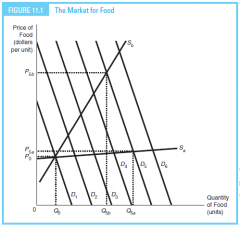
Market for Food
|
High price responsiveness to food (relatively inelastic demand curves)
Strong form represented by supply curve Sa Weak form represented by supply curve Sb |
|
|
Strong Form
|
One form of the Global Scarcity Hypothesis that suggests that per capita food production is declining-- production does not keep pace with increases in demand brought by population growth
Evidence suggests that per-capita food production in both developed and developing countries has actually increased, ruling out the strong form |
|
|
Weak Form
|
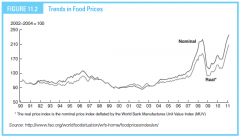
One form of the Global Scarcity Hypothesis that suggests that the supply curve is sufficiently sloped that food prices are increasing more rapidly than other prices in general, causing food insecurity from high prices
Recent evidence supports the weak form of the Global Scarcity Hypothesis |
|
|
Debt-Nature Swaps
|
An international arrangement involving the purchase of a developing country debt by a governmental environmental organization who offers to cancel the debt in return for an environmentally related action
|
|
|
Infinite-Horizon Harvesting Model
|
Considers forest harvest as an infinite sequence of harvesting and replanting, and therefore must consider interdependencies between cycles such as the opportunity cost of delay
As such, the optimal time to harvest would be shorter than in the single-harvest case, all other things equal |
|
|
Basic Forest Harvest Model (Single-Harvest)
|
The size of net benefits from wood depends on whether the land will be perpetually committed to forestry or left to natural processes after harvest. Factors include planting and harvesting costs, discount rate, growth function, and price. Age of optimal harvest (max net benefits) varies directly with discount rate.
|
|
|
Concession Agreements
|
Contractual agreements between governments and loggers that define terms under which public forests can be harvested. Loggers have a substantial advantage in harvesting existing forests over planting new forests.
Typically, governments fails to fully capture rent, and there is disincentive for loggers to exercise sustainable logging practices due to the limited term agreement. |

